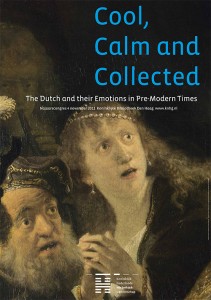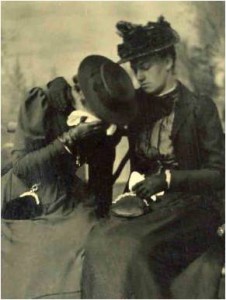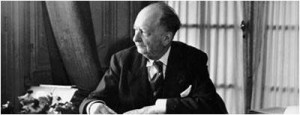 I’ve had the pleasure of speaking at two excellent history of emotions conferences in the last couple of weeks. The Netherlands Historical Society took for the theme of their 2011 conference: ‘Cool, Calm, and Collected: The Dutch and their Emotions in Pre-Modern Times’. There I learned a great deal – about the pious weeping of Dutch nuns, about Rembrandt as a master of the passions, about the ‘hotter sort of Protestant’ and their bedroom religious experiences, and about the reputation of the Dutch as phlegmatic and stolid on the one hand, and as passionate about profits on the other.
I’ve had the pleasure of speaking at two excellent history of emotions conferences in the last couple of weeks. The Netherlands Historical Society took for the theme of their 2011 conference: ‘Cool, Calm, and Collected: The Dutch and their Emotions in Pre-Modern Times’. There I learned a great deal – about the pious weeping of Dutch nuns, about Rembrandt as a master of the passions, about the ‘hotter sort of Protestant’ and their bedroom religious experiences, and about the reputation of the Dutch as phlegmatic and stolid on the one hand, and as passionate about profits on the other.
Then, here at Queen Mary, we hosted a conference on ‘Wandering Feelings: The Transmission of Emotion in the Long Nineteenth Century’, co-organised by Tiffany Watt-Smith (QMUL) and Carolyn Burdett of the Birkbeck Centre for Nineteenth-Century Studies. The emotions under discussion included national feeling, wonder, trauma, empathy, and laughter and the sources analysed ranged from paintings and poems to travel writing, science and philosophy, including George Eliot’s translation of Spinoza’s Ethics.
On both occasions I spoke about my current book project – Weeping Britannia – in one case talking about the weeping of eighteenth-century Methodists and men of feeling, and in the other about Victorian theories of tears. And in both talks I also made reference to the work of the French historian, Lucien Febvre (1878-1956).
Febvre is an important figure for anyone interested in the history of emotions. His 1941 essay ‘Sensibility and history: How to reconstitute the affective life of the past’ is widely considered a founding document in the history of emotions. It is discussed by Barbara Rosenwein, for instance, at the start of her important 2002 essay ‘Worrying about emotions in history’.
For me, Febvre is an inspiring figure. Alongside the overall vigour and vision of his writing, there are three arguments of his about the history of mentalities that I think are particularly worth remembering. First he criticised historians of ideas who wrote as if one philosophical system gave birth to another within an imponderable ether of pure thought rather than as social and cultural products. Secondly, despite his own enthusiasm for the psychological theories of his friend Henri Wallon, he warned historians against the danger of reading contemporary psychological theories and categories back into the minds and experiences of past generations. Febvre asserted (in a 1938 essay about history and psychology) that ‘the science of contemporary psychologists can have no possible application to the past’ and that psychological anachronism was ‘the worst sort of anachronism and the most insidious and harmful of all’ since each human group in the past had its own proper mental system, which worked to produce individual experiences in its own way.
Finally, in his 1941 essay on the affective life, Febvre argued that the sentiments and emotions need to be taken seriously, as complex mental attitudes comprising much more than automatic bodily responses. He issued an invitation to his fellow historians to get to work on this fascinating new field of history; to examine representations of emotions and sensibility in conduct books, court records, paintings, sculpture, music, and novels. ‘I am asking for a vast collective investigation to be opened,’ he wrote, ‘on the fundamental sentiments of man and the forms they take. What surprises we may look forward to!’ In the same essay Febvre made the following intriguing observations about emotional contagion and ritual, which seemed especially relevant to the theme of ‘Wandering Feelings’:
Emotions are contagious. …
They may well arise in the organic structure proper to a certain individual…[but] they very quickly acquire the power to set in train in all those concerned, by means of a sort of imitative contagion, the emotional complex that corresponds to the event which happened to and was felt by a single individual….
The emotions became a sort of institution. They were controlled in the same way as a ritual. Many of the ceremonies practised by primitive peoples are simulated situations with the obvious aim of arousing in all, by means of the same attitudes and gestures, one and the same emotion, welding them all together in a sort of superior individuality and preparing them all for the same action.
In both my recent talks, however, I gave the final word not to Lucien Febvre but to nineteenth-century commentators on the passions and emotions. In the Netherlands I ended with a quote from the English physician, theologian and philosopher Thomas Cogan, author of series of important treatises on the passions in the opening years of the nineteenth century. The quote from Cogan emphaises two important points, first the close connection between thoughts (opinions) and feelings, and secondly the almost infinite varieties of sentiments that can be produced by the action of different national cultures on human bodies:
But the diversities of opinions and manners, with their correspondent predilections and aversions, exceed enumeration. It is these diversities which furnish the amusement derived from the perusal of travels; and as no two nations on the globe correspond in every instance, the peculiarities of each illustrate in a striking manner the truth of our observation. They indicate the inconceivable variety of sentiments and affections, which incidentally take place among beings of the same species, inhabitants of the same sublunary system, conversant with similar objects, and possessing similar powers of mind.
At Queen Mary, I gave the last word to Frances Power Cobbe – a prolific Victorian essayists and campaigner, whose causes included female suffrage and animal rights. Her 1888 Fortnightly Review article on ‘The Education of the Emotions’ is full of interesting observations about emotions and their transmission, but one struck me particularly:
A fundamental difference between the Catholic and Puritan mind seems to be that the former seizes on every available means for producing religious emotion through the senses; the latter turns away from such means with intense mistrust, and limits itself to appeals through the mind. Dark and solemn churches like that at Assisi decorated by Giotto (which the friar who showed it told me was the “best place in the whole world for prayer”) – gorgeous altars, splendid functions, pictures, music, incense – all these are to the Catholic and the High Churchman veritable “means of grace,” i.e. they call out in them emotions which either are religious, or they think lead to religion. Long Prayers, Hymns, Bible-reading, and preachings; these, on the other hand, are the Evangelicals’ means of grace, and they produce in them emotions distinctly religious.
Again there is a clear understanding of the way that emotions can be produced by the rational mind (as well as by the senses), and I thought the appreciation of the different emotional styles of Puritans and Catholics, and their dependence on different practices and places, was very much in tune with recent work on the history of emotions of the kind I wrote about recently on this blog, with reference to Oscar Wilde, whose wonderful book The Happy Prince and Other Tales, full of sensual Catholic imagery, was published in the same year as Cobbe’s comments.
My experimental ‘Prezi’ presentation from the ‘Wandering Feelings’ event is here:


